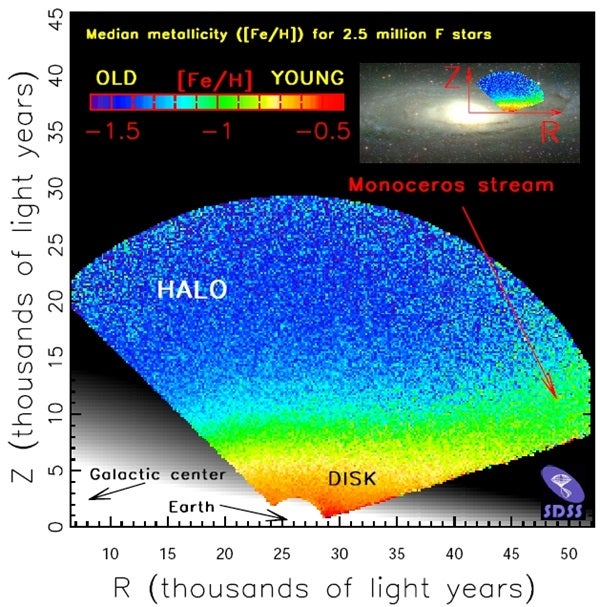An international team of astronomers from the Sloan Digital Sky Survey (SDSS-II) unveiled the most complete and detailed map yet of the chemical composition of more than 2.5 million stars in the Milky Way.
Previous chemical composition maps were based on much smaller samples of stars and didn’t go as far as the distances surveyed by SDSS-II — a region extending from near the Sun to about 30,000 light-years away. “Older sky surveys that did include a lot of stars were not accurate enough to measure their chemical composition,” explains study leader Zeljko Ivezic, a University of Washington astronomer.
“With the new SDSS map, astronomers can begin to tackle many unsolved mysteries about the birth and growth of the Milky Way,” Ivezic says.
The construction and first implications of the map are described in a paper titled “The Milky Way Tomography with SDSS: II. Stellar Metallicity,” slated to appear in the August 1 issue of The Astrophysical Journal.
Astronomers use the term metals to describe all elements heavier than hydrogen and helium, including the oxygen we breathe, the calcium in our bones, and the iron in our blood. Although hydrogen, helium and traces of lithium were created at the beginning of the universe in the Big Bang, all other elements (such as iron and carbon) were forged in the cores of stars or during the explosive deaths of massive stars.
As a result, stars that formed early in the history of the galaxy (some 13 billion years ago) were made of gas that had few metals created by the generations of stars that came before. These metal-poor stars provide astronomers with a chemical fingerprint of the origin and evolution of the elements. As subsequent generations of stars formed and died, they returned some of their metal-enriched material to the interstellar medium, the birthplace of later generations of stars, including our Sun.
“By mapping how the metal content of stars varies throughout the Milky Way, astronomers can decipher star formation and evolution, just as archaeologists reveal ancient history by studying human artifacts,” explains University of Washington graduate student Branimir Sesar, another member of the research team.
To make this new map of the galaxy, the SDSS-II team used the colors of millions of stars to infer their metal content — often referred toas metallicity. To estimate the metallicity of so many stars at once, the team compared the star colors with spectroscopic observations for many tens of thousands of these stars. A group led by SDSS-II collaborator Timothy Beers of Michigan State University devised methods to estimate the metallicities of these stars based on their spectra.
The color of a star is slightly influenced by the presence of absorption lines, where particular chemical elements absorb light at specific wavelengths. When the metals are depleted in the star, such as occurs for metal-poor stars, the amount of blue light emitted by the star is slightly increased.
“When we began the study of the metallicity of stars with the SDSS-II, we expected that we would just measure chemical compositions of the stars with spectra,” says Beers. “Spectra are time consuming to acquire, so we could only obtain estimates of metallicity for several hundred thousand stars — already a huge advance in the state of the art — using that technique. This new approach allows us to multiply our efforts by another factor of ten, a significant improvement with impressive results.”
“The map of the distribution of metallicity for several million stars reveals the differing content of chemical elements in the stellar populations of our Galaxy,” explains Ivezic. “By using two-dimensional images in different colors, we build up a three-dimensional tomographic map that clearly delineates the disk and halo components of the Milky Way.”
The metal map also shows that galaxies cannibalized by the Milky Way — including shards of one known as the Monoceros Stream — possess stars with different metal content than expected at the Stream’s position.
Many features of the map confirm standard views of the structure of the Milky Way. But, Ivezic notes, the projected motions measured for metal-poor stars appear to contradict a long-standing hypothesis of galaxy construction: that an ancient act of galactic cannibalism gave rise to the thick disk of stars enveloping the thin disk in which our star — the Sun — resides.
The SDSS-II results also provide a roadmap for future, still larger surveys, such as those planned for the 8.4m Large Synoptic Survey Telescope (LSST). LSST maps could extend ten times further, to the very edge of the Milky Way, measuring the chemical compositions of hundreds of million stars using the technique pioneered here by the SDSS-II team.










